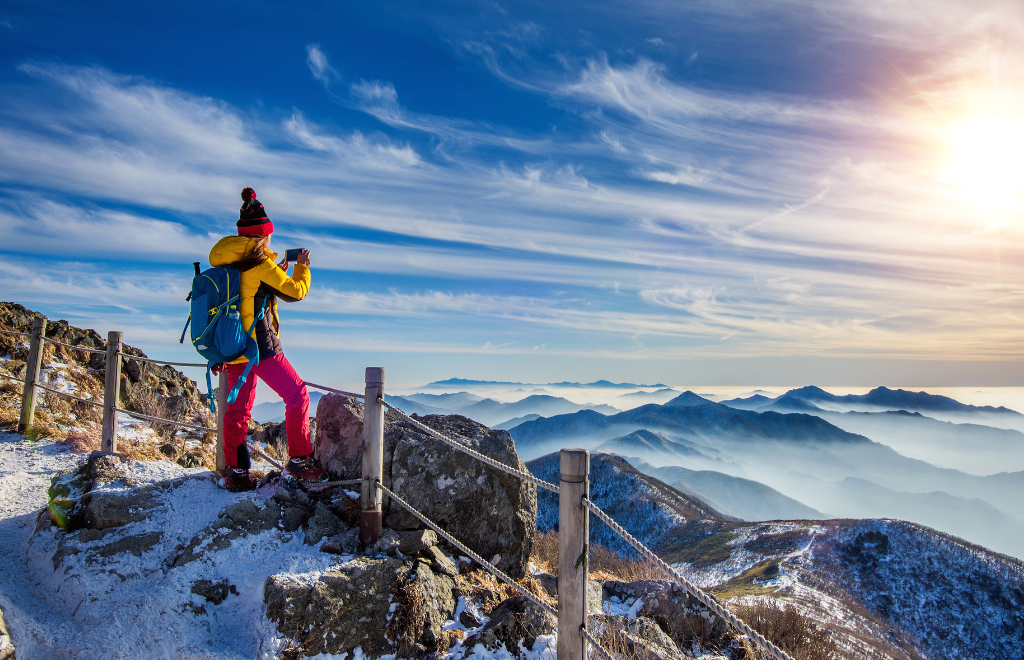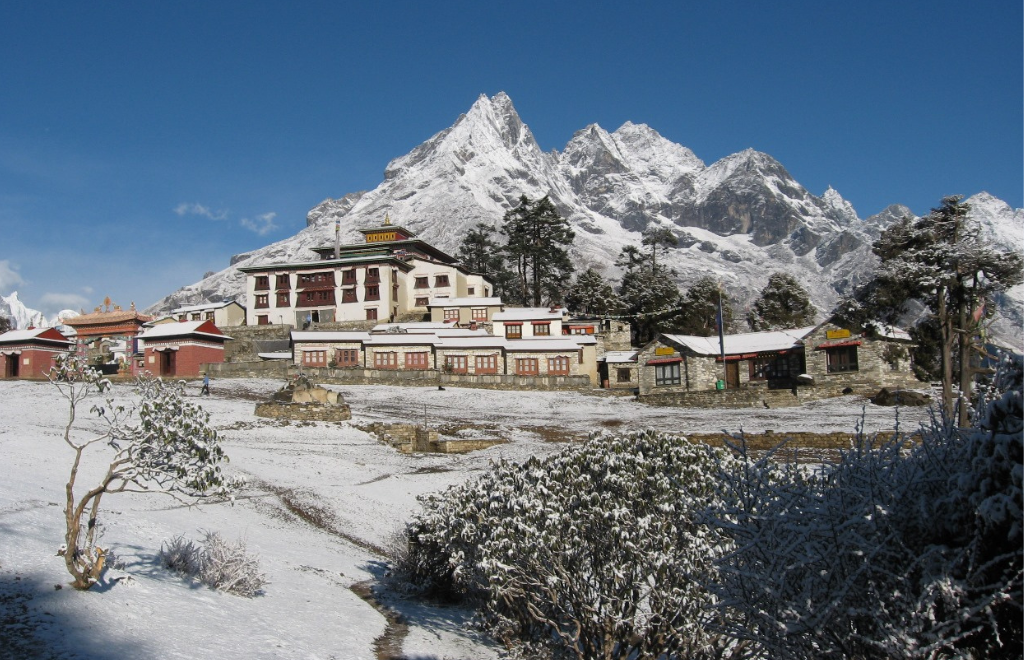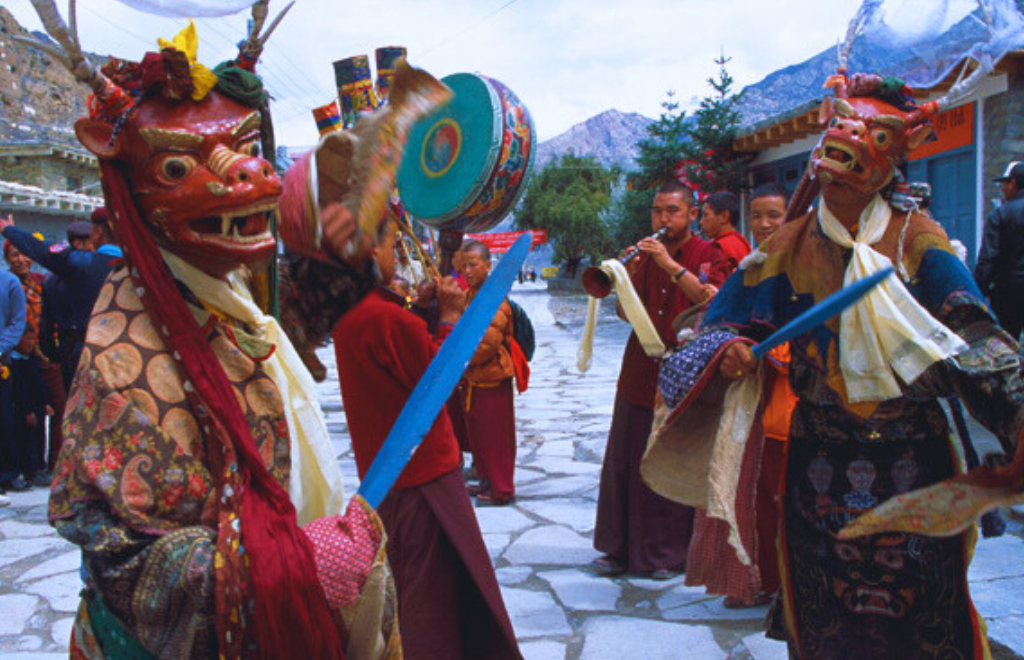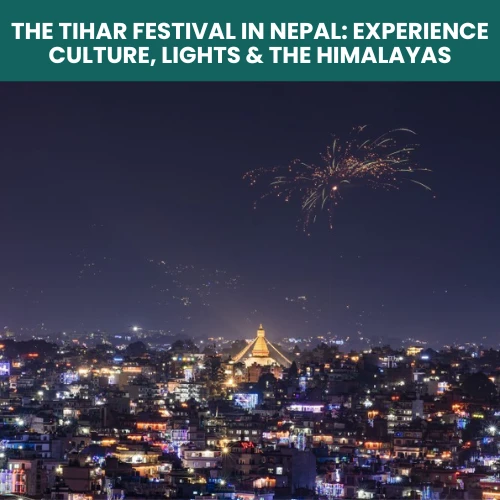Mani Rimdu Festival Explained
The Mani Rimdu Festival is a sacred festival celebrated by the Sherpa and Tibetan Buddhist communities in Nepal. Spanning 19 days, the festival is a deeply spiritual event that commemorates the founding of Buddhism by Guru Rinpoche Padmasambhava. The festival has three main phases:
- Preliminary rituals (nearly two weeks): Monks perform deity yoga, offerings to protector deities, and prayers to prepare for the main ceremonies.
- Public ceremonies (three days): Masked dances, mass empowerment, and rituals are performed in monasteries attended by villagers and international tourists.
- Closing rites (two days): Ceremonies mark the conclusion of the festival and the dissolution of mandalas created during the celebrations.
Celebrated according to the Tibetan lunar calendar, Mani Rimdu usually falls between late October and mid-November, coinciding with the full moon.
Where is Mani Rimdu Celebrated?
While the festival is observed in various monasteries across the Khumbu region, the main celebrations take place at:
- Tengboche Monastery – The largest monastery in the Everest region, where the first three days of public celebrations occur.
- Thame Monastery – Hosting rituals and cultural programs reflecting local traditions.
- Chiwong Monastery – A smaller monastery adding to the spiritual richness of the festival.
For travelers, Tengboche Monastery is the most accessible and iconic location to witness the grandeur of Mani Rimdu.
History of the Mani Rimdu Festival
The Mani Rimdu Festival traces its origins to Rongphu Monastery in Tibet in the early 1900s. It was later brought to the Khumbu region and first celebrated at Tengboche Monastery in 1938. The festival is deeply connected to the Nyingma Sect of Tibetan Buddhism and commemorates the introduction and flourishing of Buddhism by Guru Rinpoche.
The festival symbolizes the victory of Buddhism over the indigenous Bon religion and preserves the Sherpa cultural identity while promoting spiritual growth and blessings through intricate rituals.
Why is Mani Rimdu Celebrated?
The Mani Rimdu Festival is more than a cultural spectacle; it is a spiritual celebration. Key reasons for the festival include:
- Honoring Guru Rinpoche (Padmasambhava): The festival marks the introduction of Tibetan Buddhism.
- Preserving Sherpa culture: Mani Rimdu provides a platform for traditional music, dance, and rituals.
- Spiritual blessings: Ceremonies, prayers, and dances invoke protection, prosperity, and harmony.
- Community engagement: The festival fosters unity among local villagers and visitors alike.
For trekkers and cultural enthusiasts, Mani Rimdu offers a rare glimpse into the sacred practices of Tibetan Buddhism, combined with the beauty of the Himalayan landscape of Nepal.
Main Ceremonies and Rituals of Mani Rimdu
The 19-day festival includes several fascinating ceremonies. Here are the most significant highlights:
1. Sand Mandala Formation
Monks create intricate mandalas using colored sand over several days. At the center lies a bowl of Mani Rilwu pills (spiritual medicine), surrounded by protective symbols representing deities. The mandala symbolizes peace, compassion, and blessings for all attendees.
2. Wong (Empowerment Ceremony)
The first day of the public festival features Wong, a sacred empowerment ritual. Attendees receive Rilwu (blessed pills) and Tshereel pills for long life and spiritual protection. The ceremony includes purification rituals and prayers performed by the head Lama.
3. Chham (Masked Dance)
On the second day, monks perform the Chham dance, wearing masks of demons and protectors. The dances depict the victory of good over evil, combining spiritual philosophy with visually stunning performances. The skillful and symbolic movements of the dancers enchant spectators.
4. Ser-Kyem (Offering of Drinks)
During Ser-Kyem, monks offer drinks to the Dharma Guru and other protective deities. The ceremony involves a unique serving method where the drink overflows from a small glass into a larger bowl, symbolizing abundance and unity. This ritual strengthens bonds within the community.
5. Jinsak (Fire Puja)
The third day includes Jinsak, or the Fire Puja, where monks burn grains and butter to purify the world and dispel negative energy. The sand mandala created earlier is destroyed, symbolizing the impermanence of life.
6. Chhingpa Dance
Chhingpa represents the four Ghings, protectors of Buddhism. Dancers wear colorful, shining masks and engage the audience with dramatic movements, invoking awe and spiritual reflection. The dance also embodies Dakini practices, blending the symbolic energies of male and female.
When is the Mani Rimdu Festival in 2025?
In 2025, the festival’s public celebrations at Tengboche Monastery will take place on November 5, 6, and 7. While the full 19-day festival spans the lunar month, these first three days are open to visitors and international tourists. Dates vary each year according to the Tibetan lunar calendar, so planning early is essential.

A Trekker’s Guide to Mani Rimdu Festival
For adventure seekers, combining the Mani Rimdu Festival with a trek to Everest Base Camp or Gokyo Lakes offers one of the most rewarding experiences in the Himalayas. The festival not only provides a deep cultural connection but also adds a meaningful spiritual dimension to your trekking journey.
How to Reach Tengboche for Manni Rindu Festival
To attend the Mani Rimdu Festival, most trekkers begin their journey with a short flight from Kathmandu to Lukla (2,860m). From Lukla, the trek to Tengboche Monastery (3,867m) typically takes 4–5 days, passing through scenic Sherpa villages such as Phakding, Namche Bazaar, and Khumjung. Along the way, trekkers enjoy views of Everest, Ama Dablam, and Thamserku, while gradually acclimatizing to higher altitudes.
Alternatively, for those seeking a longer adventure, you can include routes toward Everest Base Camp, Gokyo Lakes, or the Three Passes Trek, all of which can be combined with the Mani Rimdu celebrations.
Altitude and AMS Health Tips for Safe Trekking
The Tengboche area lies at nearly 3,900 meters, where trekkers may begin to feel the effects of altitude sickness (AMS). To stay healthy and enjoy the festival comfortably:
- Ascend gradually and include acclimatization days in Namche Bazaar.
- Stay hydrated and avoid alcohol or smoking.
- Eat balanced meals with plenty of carbohydrates.
- If symptoms like headache, dizziness, or nausea occur, rest or descend to a lower altitude.
- Always consult your guide before taking altitude medication.
Proper acclimatization not only ensures safety but also lets you fully experience the festival’s spiritual and cultural atmosphere without discomfort.
Trip Preparation and Essentials for Mani Rimdu Festival in the Everest Region
Attending the Mani Rimdu Festival requires both physical readiness and proper planning. Here are a few essential tips:
- Physical Fitness: Engage in regular hikes or cardio workouts before your trek.
- Clothing: Pack warm layers, a down jacket, thermal wear, and comfortable trekking boots for cold mountain nights.
- Gear: Carry a sleeping bag (rated -10°C), trekking poles, and a headlamp.
- Permits: Obtain the Sagarmatha National Park Permit and the Khumbu Pasang Lhamu Rural Municipality Permit in advance.
- Guides and Porters: Hiring a local guide not only enhances safety but also offers cultural insights during the festival.
By combining trekking and cultural immersion, you experience both the natural beauty and spiritual richness of Nepal in one unforgettable journey.
A1 Excursion Adventure Travel Packages for Everest Trek and Mani Rimdu Festival 2025
At A1 Excursion Adventure, we offer specially curated trekking packages to coincide with the Mani Rimdu Festival:
16 -Day Everest Trek with Mani Rimdu Experience
Everest Base Camp Short Trek (10 Days)
Everest Panorama View Trek (6 Days)
All packages include experienced guides, accommodation, meals, and local support, ensuring a safe and unforgettable adventure.

Why Attend the Mani Rimdu Festival 2025?
Attending the Mani Rimdu Festival offers a rare combination of:
- Spiritual enrichment – Witness ancient rituals and prayers.
- Cultural immersion – Experience Sherpa traditions and Tibetan Buddhist heritage.
- Adventure – Trek through stunning Himalayan landscapes.
- Photographic opportunities – Capture mesmerizing dances, ceremonies, and scenic vistas.
This festival is perfect for travelers seeking authentic cultural experiences combined with adventure trekking in Nepal.
Conclusion
The Mani Rimdu Festival at Tengboche Monastery is more than a cultural event; it’s a spiritual awakening amidst the world’s highest peaks. As monks perform sacred dances and prayers echo through the monastery, visitors experience the timeless connection between faith, nature, and community.
Whether you’re trekking to Everest Base Camp, Gokyo Lakes, or exploring the Sherpa heartland, timing your journey with the Mani Rimdu Festival allows you to witness Nepal’s living heritage in its purest form.
Contact us today to join the 2025 Mani Rimdu Festival Trek and immerse yourself in the beauty and spiritual magic of the Himalayas with A1 Excursion Adventure here in Nepal.
FAQs [Frequently Asked Questions]
1. What is the Mani Rimdu Festival in Nepal?
The Mani Rimdu Festival is a sacred Buddhist celebration held annually in the Everest region of Nepal. It honors Guru Rinpoche (Padmasambhava), the founder of Tibetan Buddhism, through masked dances, prayers, and spiritual rituals performed by monks at Tengboche Monastery.
2. Where is the Mani Rimdu Festival celebrated?
The festival is primarily celebrated at Tengboche Monastery in the Everest region, with smaller celebrations at Thame and Chiwong Monasteries. Tengboche is the most famous location, attracting both local devotees and international trekkers.
3. When is the Mani Rimdu Festival in 2025?
In 2025, the Mani Rimdu Festival’s public celebrations at Tengboche Monastery are expected to take place on November 5th, 6th, and 7th. The full festival spans about 19 days, following the Tibetan lunar calendar, so dates vary each year.
4. Why is the Mani Rimdu Festival celebrated?
The festival commemorates the introduction of Buddhism to Tibet by Guru Rinpoche. It symbolizes the victory of compassion and wisdom over ignorance and evil, promoting peace, harmony, and spiritual awakening within the Sherpa community.
5. Can tourists attend the Mani Rimdu Festival?
Yes, tourists are welcome to attend the Mani Rimdu Festival, especially the public ceremonies at Tengboche Monastery. Visitors can observe masked dances, fire pujas, and blessings while respecting monastery customs and local traditions.
6. How can I experience the Mani Rimdu Festival while trekking?
Trekkers can plan their Everest Base Camp, Gokyo Lakes, or Everest Panorama Trek to coincide with the festival dates. Many trekking agencies, including A1 Excursion Adventure, offer special Mani Rimdu Festival trek packages that combine culture, spirituality, and adventure.
7. What should I know before attending the Mani Rimdu Festival?
Dress modestly, maintain silence during rituals, and always ask permission before taking photos. It’s also best to book accommodations early, as lodges near Tengboche fill up quickly during the festival season.


.webp)



-1.webp)
-1.webp)
